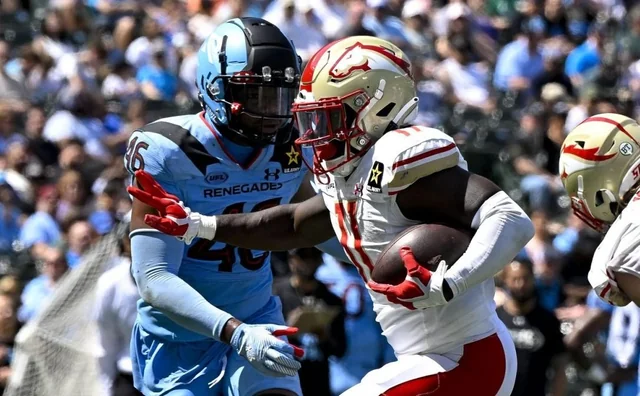On Friday, March 28, 2025, the United Football League (UFL) kicked off its inaugural season, introducing a new era of spring football designed to offer athletes a second chance at making a name for themselves in the professional football world. While spring football leagues like the XFL and the USFL have provided similar opportunities in recent years, the UFL is positioning itself to carve out its unique identity in the football ecosystem. With a focus on providing a platform for talented players, coaches, and front-office personnel to showcase their skills, the UFL promises to bring exciting football action to fans during the NFL offseason.
This spring football league is poised to become a significant part of the football landscape, offering an alternative pathway for players who may not have made it to the NFL or other major leagues, or for those who have been overlooked, underappreciated, or simply need more development. But what makes the UFL different from other spring leagues, and what impact can it have on players’ careers? As the UFL begins its journey, let’s dive deeper into the league’s structure, its potential, and how it serves as a crucial opportunity for players aiming to impress, develop, and one day reach the highest level of professional football.
The Birth of the United Football League
The United Football League was conceived out of a desire to create more opportunities for athletes in the football world. For years, players aspiring to break into the NFL or receive another shot at professional football have found themselves either sitting on the sidelines or playing in obscure leagues that failed to gain traction. With the NFL dominating the American football landscape, it can be incredibly difficult for up-and-coming players to find an outlet to display their talents.
Enter the UFL, a league designed to provide those players with an opportunity to continue their careers. The UFL was founded by a group of experienced sports executives, including former NFL players, coaches, and analysts who understand the struggles of many football players who don’t get the chance to showcase their abilities on the NFL stage. Through the league, players will not only have the chance to impress coaches and scouts but also refine their skills, gain valuable experience, and develop their football careers in ways that other leagues haven’t provided.
While many spring leagues in the past have failed to gain long-term viability, the UFL is hoping to differentiate itself by creating a sustainable model that emphasizes both high-quality football and player development. Backed by a strong financial foundation, partnerships with respected football figures, and a clear focus on attracting top talent, the UFL has the potential to become a fixture in the spring football landscape.
The UFL’s Mission: Offering a Shot for Players to Impress
At its core, the UFL is built around one key idea: giving players another shot. Many players come from non-traditional football backgrounds or are overlooked during the draft process, meaning they miss out on the opportunity to show what they can do in front of NFL scouts and coaches. The UFL wants to provide these players with the platform they need to prove themselves and enhance their professional careers.
A key differentiator for the UFL is its commitment to player development. Players who enter the league are given the time and space to develop their skills on the field, something that can be a challenge in a system where the focus is often on immediate success. The UFL coaches are not only experienced and accomplished but also have a deep understanding of how to help players improve and reach their full potential. Many of the league’s coaching staff have been involved with the NFL in some capacity, and their expertise can be vital in helping players refine their game.
Whether it’s quarterbacks trying to improve their decision-making, wide receivers working on route running, or defensive players refining their tackling techniques, the UFL provides an environment where athletes can develop without the pressure of playing for an NFL team. Coaches will have the freedom to experiment with different schemes, playbooks, and strategies that are designed to suit the needs of the players rather than focusing solely on wins and losses.
The UFL’s Structure and Format
The United Football League operates as a professional spring football league, which means that it will begin play each year after the conclusion of the NFL season. The primary goal is to fill the football void during the offseason, keeping fans engaged with exciting and competitive action while providing a place for players to show what they’re capable of.
The league consists of teams that compete in a regular season, with playoff spots awarded to the highest-performing teams. The UFL will follow a format similar to the NFL in terms of regular-season games, allowing players to showcase their skills on the big stage. The league’s season runs from March to June, with games scheduled primarily on weekends to give fans the best chance to watch.
In terms of its team composition, the UFL draws talent from various sources, including undrafted NFL players, former NFL players looking for a return to the league, players from smaller collegiate programs, and international players. Scouting systems in the UFL are designed to identify the best available talent, creating a league where the playing field is as open as possible. Each team is tasked with selecting a mix of promising rookies and veteran players, with an emphasis on creating a competitive and balanced league.
The UFL features a standard 16-game regular season, with teams facing each other in a round-robin format. The league’s playoff structure culminates in a championship game, which provides a tangible goal for players to strive for throughout the season. Not only does this competitive format help fans stay engaged, but it also drives the sense of urgency for players looking to showcase their skills on the field.
The Importance of the UFL for Player Development
For many players, the UFL is the chance they’ve been waiting for to showcase their skills and prove their worth. Some athletes may have been drafted by the NFL but didn’t make the final roster, others may have suffered from injury setbacks or struggled to find the right fit, and still, others may not have received attention from NFL scouts at all. The UFL represents a second chance for these athletes.
One of the most important aspects of the UFL is that it offers a platform for players to perform in front of professional-level scouts and coaches. While NFL teams may not be actively scouting the UFL during the regular season, it’s common for NFL teams to monitor spring leagues to identify players who can contribute in the future. As a result, athletes who have struggled to break through to the NFL could find success through this secondary league, which provides a direct pathway to the NFL.
The UFL will also create an environment where players can refine their technical abilities. For example, quarterbacks will benefit from having access to professional coaches who can fine-tune their mechanics, develop their pocket presence, and teach them how to read defenses. Wide receivers will gain more opportunities to work on their route running and timing with quarterbacks, while defensive players will sharpen their tackling, coverage skills, and awareness of different offensive schemes.
UFL’s Potential Impact on the NFL
The UFL offers an interesting opportunity for the NFL. While the UFL is not an NFL-affiliated league, it operates in a similar way to previous spring leagues like the XFL and USFL by providing players with a secondary platform to showcase their talents. This setup can benefit the NFL by giving teams another layer of talent to evaluate and tap into.
NFL teams can use the UFL as a scouting ground for players who might be on the fringe of their roster or as a place to spot future stars. For example, a young quarterback who needs more playing time could be sent to the UFL to develop his skills in a real-game environment. As players improve in the UFL, it gives the NFL teams an opportunity to see them in action before potentially offering them a contract. In this way, the UFL serves as a supplemental pipeline for the NFL, helping teams to develop their talent pool and find hidden gems.
Furthermore, with the NFL constantly seeking more diverse and innovative talent, the UFL may become a breeding ground for fresh ideas and new schemes that could influence the way the NFL operates. Players who perform well in the UFL, particularly in key positions like quarterback, running back, and wide receiver, could change the way NFL teams evaluate prospects, opening the door for a broader range of athletes to make their mark at the next level.
What the UFL Means for Fans
For football fans, the UFL provides an exciting new avenue to enjoy professional football during the offseason. While the NFL dominates the fall and winter months, fans often feel a significant void after the season ends. With the UFL offering high-quality games through the spring months, fans are no longer left without the sport they love.
The UFL’s presence in the spring football market is set to enhance the experience for football lovers by introducing a fresh brand of football. The league’s unique opportunity to witness up-and-coming stars and former NFL players looking for a second chance will add layers of intrigue and excitement to each game. Whether it’s watching a quarterback make a comeback or witnessing an underdog rise to stardom, the UFL has the potential to provide a rich and diverse football viewing experience.



